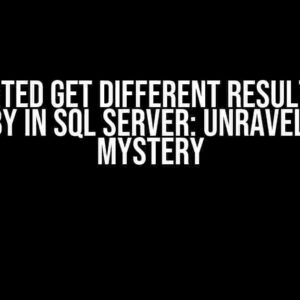When working with collections in C#, there are times when you need to return an empty IEnumerable. This might seem like a trivial task, but it’s essential to do it correctly to avoid bugs, improve performance, and make your code more maintainable. In this article, we’ll dive into the world of empty IEnumerables, exploring the reasons why you need them, how to create them, and best practices to keep in mind.
Why Return an Empty IEnumerable?
So, why do you need to return an empty IEnumerable in the first place? There are several reasons:
- Avoid null references**: Returning null can lead to NullReferenceExceptions, which can be frustrating to debug. By returning an empty IEnumerable, you ensure that your code is more robust and less prone to errors.
- Improve code quality**: An empty IEnumerable is a more descriptive and intuitive return value than null. It clearly indicates that the collection is empty, making your code easier to understand and maintain.
- Enhance performance**: In some cases, returning an empty IEnumerable can improve performance by avoiding unnecessary null checks and reducing the risk of exceptions.
Creating an Empty IEnumerable
Now that we’ve covered the why, let’s dive into the how. There are several ways to create an empty IEnumerable in C#:
Method 1: Using the Enumerable.Empty<T> Method
public IEnumerable<string> GetEmptyEnumerable()
{
return Enumerable.Empty<string>();
}This is the most straightforward approach. The Enumerable.Empty<T> method returns an empty IEnumerable of the specified type (T in this case).
Method 2: Using the Array.Empty<T> Method (C# 11 and later)
public IEnumerable<string> GetEmptyEnumerable()
{
return Array.Empty<string>().AsEnumerable();
}In C# 11 and later, you can use the Array.Empty<T> method to create an empty array and then convert it to an IEnumerable using the AsEnumerable() method.
Method 3: Creating an Empty List and Returning It
public IEnumerable<string> GetEmptyEnumerable()
{
return new List<string>().AsEnumerable();
}This approach creates an empty list and returns it as an IEnumerable. While it works, it’s less efficient than the first two methods, as it creates an unnecessary list instance.
Best Practices and Considerations
When returning an empty IEnumerable, keep the following best practices and considerations in mind:
Use the Most Appropriate Method
Choose the method that best fits your use case. If you’re using C# 11 or later, the Array.Empty<T> method is a good choice. Otherwise, stick with Enumerable.Empty<T>.
Avoid Creating Unnecessary Objects
Method 3, creating an empty list and returning it, can lead to performance issues and unnecessary object creation. Avoid this approach whenever possible.
Consider the Context
Return an empty IEnumerable only when it makes sense in the context of your code. If your method is designed to return a non-empty collection, throwing an exception or returning null might be more appropriate.
Real-World Scenarios
Let’s explore some real-world scenarios where returning an empty IEnumerable is beneficial:
Filtering a Collection
public IEnumerable<string> FilterCollection(IEnumerable<string> collection, string filterTerm)
{
if (string.IsNullOrEmpty(filterTerm))
{
return Enumerable.Empty<string>();
}
// Apply filtering logic here
return collection.Where(item => item.Contains(filterTerm));
}In this example, if the filter term is empty, we return an empty IEnumerable to indicate that the collection is empty.
Retrieving Data from a Database
public IEnumerable<Customer> GetCustomers(string criteria)
{
using (var db = new DbContext())
{
var customers = db.Customers.Where(c => c.Name.Contains(criteria));
if (!customers.Any())
{
return Enumerable.Empty<Customer>();
}
return customers;
}
}In this scenario, we return an empty IEnumerable if no customers match the specified criteria.
Conclusion
In conclusion, returning an empty IEnumerable in C# is a crucial aspect of writing robust, efficient, and maintainable code. By understanding the reasons why you need to return an empty IEnumerable, the different methods to create one, and the best practices to keep in mind, you’ll be well-equipped to tackle a wide range of scenarios. Remember to use the most appropriate method, avoid creating unnecessary objects, and consider the context of your code.
| Method | Description | Recommended |
|---|---|---|
Enumerable.Empty<T> |
Returns an empty IEnumerable of type T |
Yes |
Array.Empty<T> |
Returns an empty array of type T and converts it to an IEnumerable |
Yes (C# 11 and later) |
| Creating an empty list and returning it | Creates an empty list and returns it as an IEnumerable | No |
By following the guidelines and best practices outlined in this article, you’ll be able to write more efficient, readable, and maintainable code that correctly handles empty IEnumerables.
Here are 5 Questions and Answers about “Return empty IEnumerable” with a creative voice and tone:
Frequently Asked Question
Get the inside scoop on returning empty IEnumerable – we’ve got you covered!
Why do I need to return an empty IEnumerable instead of null?
Returning an empty IEnumerable is a good practice because it prevents null reference exceptions. When you return null, you’re leaving it up to the caller to handle the null case, which can lead to unexpected behavior and crashes. By returning an empty list, you’re providing a predictable and safe result that can be easily handled by the calling code.
How do I return an empty IEnumerable in C#?
In C#, you can return an empty IEnumerable using the `Enumerable.Empty
Is it okay to return an empty list instead of an empty IEnumerable?
Yes, it’s generally okay to return an empty list instead of an empty IEnumerable, especially if you’re working with a specific type that’s known to be a list. However, keep in mind that returning an empty IEnumerable provides more flexibility and genericity, as it can be used with any type that implements IEnumerable. So, if you’re unsure or need to support multiple types, stick with returning an empty IEnumerable.
What are some common scenarios where I might need to return an empty IEnumerable?
You might need to return an empty IEnumerable when you’re working with data that’s not found, such as an empty database query result, or when a filtering operation yields no results. You might also need to return an empty IEnumerable when you’re handling exceptions or errors, or when you’re providing a fallback value for a method that can’t produce a result.
Can I use the yield return statement to return an empty IEnumerable?
No, you can’t use the yield return statement to return an empty IEnumerable. The yield return statement is used to produce a sequence of values in a iterator block, but it doesn’t produce an empty sequence. Instead, use the `Enumerable.Empty
Let me know if this meets your requirements!


